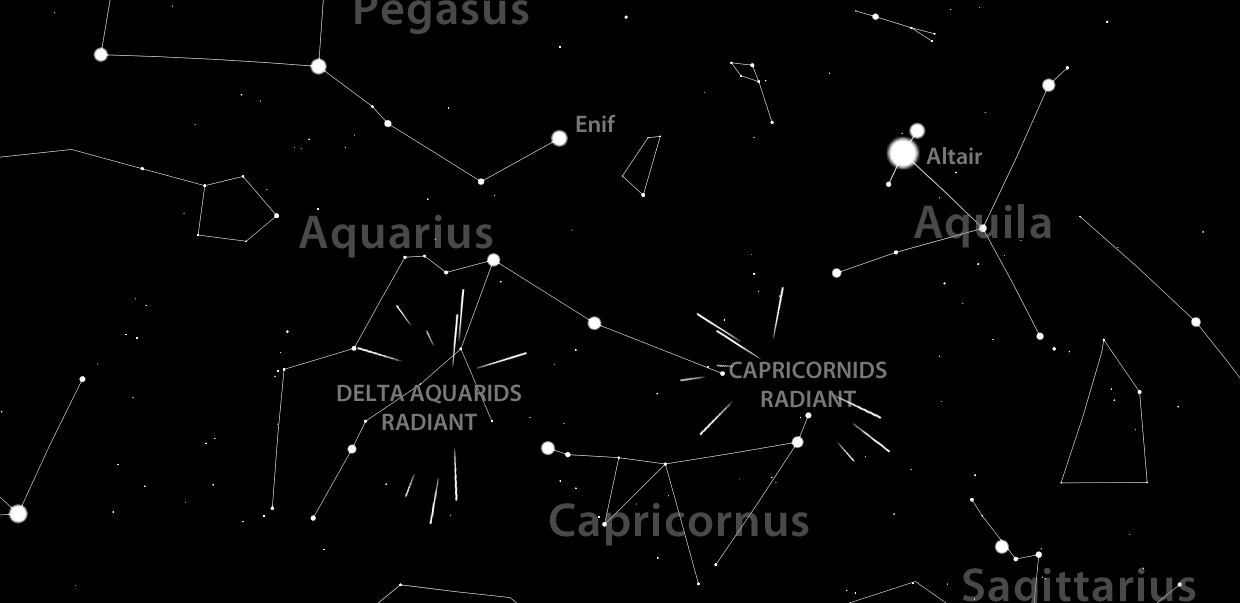
Astronomical Potpourri in July
July 2014 :
Note: This article may contain outdated information
This article was published in the July 2014 issue of The Skyscraper and likely contains some information that was pertinent only for that month. It is being provided here for historical reference only.
Summer months present unique challenges to stargazers. While the Milky Way and all its glory awaits exploration, one cannot begin to observe until 9:30 p.m. or later, and dawn’s early light curtails viewing early in the morning. And depending upon the weather, summer haze can interfere with observing fainter objects like clusters and galaxies. Add the onslaught of pesky mosquitoes to that fairly narrow window, and some of us already start to think of the cooler days of Fall.
Despite these minor inconveniences, July does provide many interesting opportunities to enjoy the wonders of the heavens.
While Jupiter has been lost to view towards the western sky, Mars and Saturn can still be seen towards the southwest after sunset. Saturn’s rings are outstanding. Since Mars’ close approach of 57,406,300 miles on April 14, the Earth has been rapidly pulling away from this red planet. On July 1, Mars will appear as a small disk approximately 92,485,839 miles away us. Little detail will be visible on the rust-colored surface through small telescopes. However, some of the larger instruments at the local observatories may still reveal subtle dusky markings on its surface.
If you have trouble trying to locate these two planets in the sky, the Moon can help you to find each of them on two different nights. On July 5th a First Quarter Moon will pass below Mars. If the weather is clear, Seagrave Observatory will be open from 9:00-11:00 p.m. to offer views of this conjunction during our normal Saturday open night schedule. Saturn will also be visible that evening. Two nights later on the 7th the Moon will pass below Saturn. In both scenarios, an observer will be able to detect the Moon’s eastward motion in a fairly short period of time.
For you early morning risers, Venus is the brilliant beacon in the eastern sky. By July 15, Mercury will be about six degrees to the lower left (seven o’clock position) of Venus. Mercury will be visible for several days before and after this conjunction. At that time, Venus’ phase will appear like a waning gibbous Moon through a telescope, whereas Mercury will appear like a waning crescent.
While it may seem counter intuitive to northern hemisphere residents, the Earth is at aphelion (farthest from the Sun) on July 3 at about 94,506,507 miles. It just so happens that the tilt of the Earth’s polar axis has the northern hemisphere tipped toward the Sun at that time, providing more direct sunlight for us. At perihelion (Earth closest to the Sun) back on January 4, the Earth-Sun distance was 91,406,673 miles. The difference, just over three million miles (or 7 percent), has little effect on our planet. However, northern hemisphere summer is warmer than its southern hemisphere counterpart because of the fact that there is much more land mass north of the Earth’s equator to absorb the solar radiation.
And finally, let’s talk about meteor showers. Remember the hype for the new May Camelopardalids, forecast to exceed 100+ meteors per hour from 2:00-4:00 a.m. on May 24? Locally we were clouded out. But we didn’t miss anything. The hype was more prolific than the display itself. The grandiose meteor display failed to materialize. The most meteors any observer saw was about 10-15 per hour during the predicted peak. Better luck next time (if there is a next time)!
For northern hemisphere meteor observers July is not very productive. Centered on July 30 there are two meteor displays that are best seen from the southern hemisphere where the constellations that the meteors appear to radiate from are much higher in the sky. Regardless, between midnight and dawn on July 28, 29 and 30, you can glimpse members of both of these overlapping showers. Moonlight will not interfere, but the observing window is short due to dawn’s early light beginning very early.

The first meteor shower, the Delta Aquarids, peak from July 28-30, with the morning of the 29th being the best time to observe. An observer well away from light-polluted skies can expect to see about 20 bright, yellow meteors per hour. Because these meteors nearly broadside the Earth, their speed is a moderate 25.5 miles per second.
The second meteor shower you should observe comes a day later on the morning of July 30 with the peak of the Alpha Capricornid meteor shower. You will also see some Alpha Capricornids on the morning of the 29th as well. The Alpha Capricornids are also yellow meteors and are noted for producing brilliant fireballs. They are relatively slow cometary dust particles, hitting our atmosphere at around 15 miles per second. You can expect only 15 meteors per hour.
Aquarius and Capricornus, the constellations from which these shooting stars appear to emanate, will be just less than halfway between the southern horizon and zenith (straight up) around 2:00 a.m. Make an effort to observe these meteor displays if it is clear. Do not wait for the Perseids on August 11-13, for a very bright Moon (Full on the 10th) will then severely hamper observing this usually worthwhile meteor shower.
Though it doesn’t get sufficiently dark to observe the heavens until after 9:15 p.m. or so during July, all of the local observatories will remain open during the summer months. Ladd Observatory in Providence is open every clear Tuesday night. Seagrave Memorial Observatory in North Scituate is open every clear Saturday night. And if you wish to observe from the darkest skies in Rhode Island, make the journey to Charlestown and visit Frosty Drew Observatory on any clear Friday night. Please visit the respective websites for details.
As always, keep your eyes to the skies.



